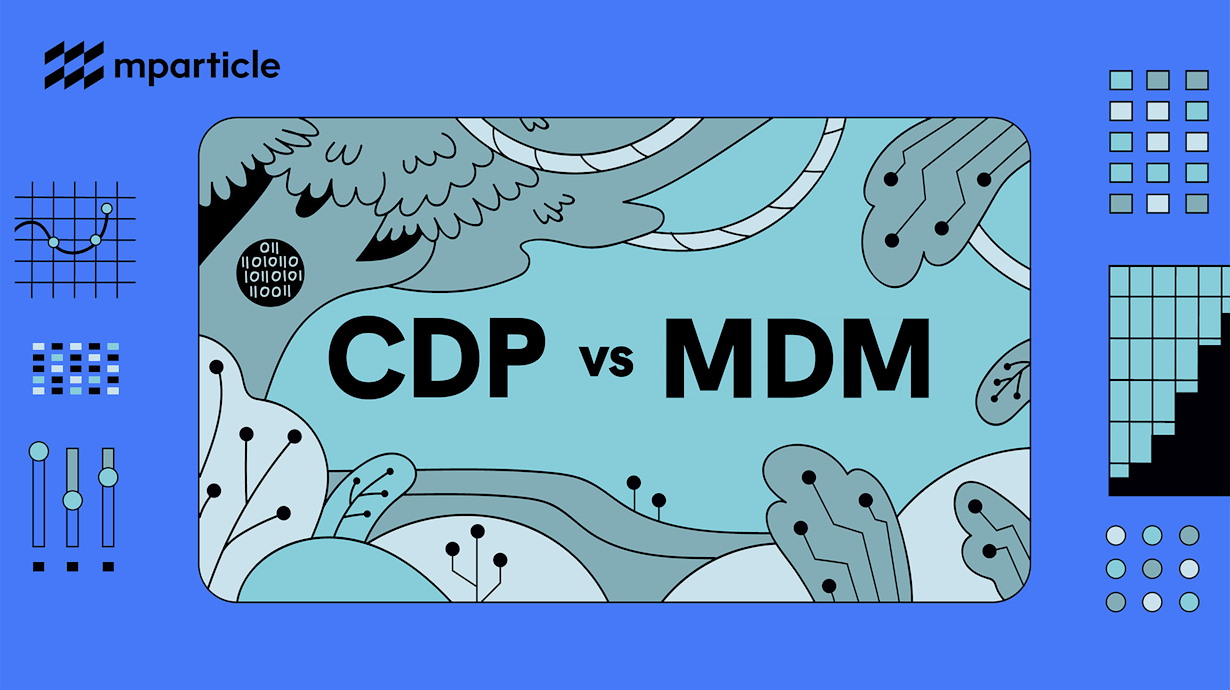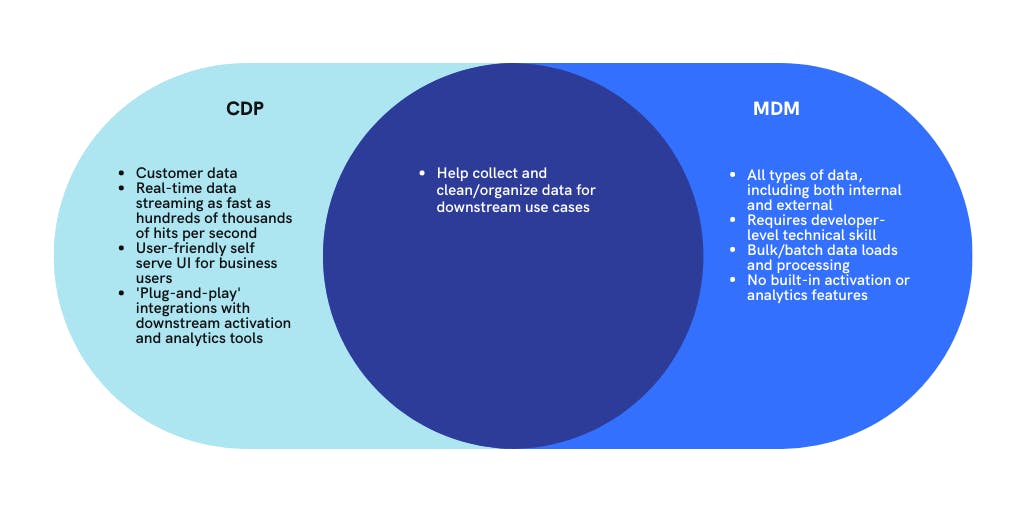CDP vs. MDM: What’s the difference and which one should you use?
Although both solutions provide a centralized data foundation, Customer Data Platforms and Master Data Management are not mutually exclusive. This article discusses the differences between CDPs and MDMs, and clarifies when each solution should be used.

As technology grows and the data market expands, every day brings more tools and data platforms through which to parse. With so many solutions available, there’s an ideal data stack to help every company harness data and turn it into a better customer experience and higher revenue.
The challenge is in figuring out what that ideal stack looks like for your organization.
For marketers, the focus is on activating customer data in a way that drives efforts like personalization, ad targeting, analytics, and more. Doing so requires a tool built for data activation, but it also requires quality data to power it.
Ensuring their stack is built on clean, accurate, high-quality data has led many to wonder about processes like Master Data Management (MDM) and the difference between an MDM solution and a Customer Data Platform (CDP).
To help you develop a better understanding of each—and whether you need one or both of them—this article covers:
- How both CDPs and MDM work
- The primary differences between them—including the use cases each is built for
- Whether you should be thinking in terms of “CDP vs. MDM” or “CPD + MDM”
What is MDM and what can it do?
Master data management (MDM) actually has two definitions. It refers to both the process of unifying and structuring data into one single “master data” set and to the various enterprise tools and platforms that help companies actually do it.
As Gartner explains it, master data management (MDM) is “a technology-enabled discipline in which business and IT work together to ensure the uniformity, accuracy, stewardship, semantic consistency and accountability of the enterprise’s official shared master data assets.”
If that sounds generic, it’s because MDM is a wide-ranging process. It involves moving around all kinds of both data—from sources like your CRM platform, ERP system, manufacturing data, and more. That data can be external, involving information about your customers and end users, or internal data about your own employees.
The main goal is to collect, clean, and organize data from all your sources into a single dataset that’s structured and ready to use in other downstream tools. Typically, that dataset is then stored in your data warehouse or data lake, where it can then be leveraged for business intelligence or connected to other systems for activation.
Unlike many tools focused on marketing and external customer data, MDMs aren’t built for speed. Instead of stream processing, data is loaded in large—usually slow—batches. These tools also aren't built for activation. MDM solutions sit squarely upstream in the data stack and don’t include user-friendly features to visualize, digest, and operationalize data.
That works for the use case of MDM tools, but it’s extremely limiting for teams like marketing and product.
MDM, as a process, is a big undertaking for brands, too—it often requires a number of tools and extensive technical resources to implement. Additionally, the more data you have, the more expensive it becomes.
The right tool for your customer data
There’s no doubt MDMs are valuable in terms of ensuring clean, accurate, structured, and unified data that can be used across the organization. In fact, for many internal, cross-departmental use cases, a master data set is an absolute necessity.
But from the standpoint of business users (like marketing, product, and sales, for example), master data isn’t very useful unless you have a way to:
- Make it accessible and digestible for business users
- Visualize data and give it meaning, via customer journey mapping, audience-building and segmentation, and more
- Activate it via downstream tools to turn data into email campaigns, push notifications, and other conversion-driving activities
MDMs can’t do that—because it isn’t the use case they’re built for. That’s where Customer Data Platforms (CDPs) come into play.
What is a CDP and how can it help?
CDPs provide marketers with a single platform from which to collect, manage, transform, and activate customer data from all of your data sources.
With a CDP, you can collect and pull in customer and event data from a variety of sources, both client-side and server-side, operationalize it in the form of things like user profiles and custom audiences, and then forward that data downstream into your activation tools to power analytics, marketing campaigns, and personalization.
In other words: CDPs collect data on customers and how they interact with your product or service and make it easier to connect that data to additional third-party systems.
Designed for customer data activation
Here’s the bottom line difference between CDP vs. MDM: only one is built for customer data activation, and that’s your CDP.
As the name implies, CDPs process customer (read: external) data only. That includes demographic data on customers, personally identifiable information (PII) like names and email addresses, and behavioral data on how customers interact with your website, app, and other digital products.
CDPs pull that data from a variety of sources—including device and event data, marketing automation software, and your CRM—and use it to help build an accurate, holistic view of your customers.
But CDPs aren’t built to just aggregate this data. They compile it into universal customer profiles you can use to drive downstream marketing efforts like personalization, ad targeting, and customer journey analytics, to name a few.
Once you build audiences and profiles in a CDP, you can put it to work across:
- Ad platforms like Google Ads and Facebook
- Other marketing tools for email marketing, push and SMS marketing, and more
- Analytics and Business Intelligence (BI) tools like Indicative or Tableau
- Customization and personalization software
- Even customer service and chat solutions
(See what’s possible by exploring our use case library)
User-friendly interface
MDM is a back-end, technical process—so MDM software doesn’t include features atop it to power things like data visualization and analytics. It’s built for developers, IT, and other highly technical users.
CDPs are designed to make customer data easily accessible to marketers, product teams, and other business users. Users of varying technical skill can easily use the CDP platform on their own—without adding delays or requiring technical resources to query and understand the data.
A good CDP comes with user-friendly, self-service tools that enable marketers to:
- Build customer audiences and segments
- Integrate with other tools in as little as one click
- Import audiences and segments into activation tools automatically
- Quickly view calculated attributes within the system
- Look up user profiles quickly and easily
Real-time access and activation
Because of the use cases they power, CDPs are built for speed.
Think about it: if a customer interacts with your app—say, they add a product to their cart, then abandon it—you need to have that information, along with the customer’s profile, available in real-time. Without it, you can’t trigger an abandoned cart email sequence right away, for example.
CDPs power this level of real-time personalization and activation through streaming, which processes data in—you guessed it—real time. They’re built to stream data at rates as fast as tens or hundreds of thousands of hits per second, all while solving for things like identity resolution and privacy in real time.
MDMs aren’t built for that kind of speed because most of the use cases for MDM software don’t require it. Instead, MDMs tend to load data in larger, slower batches.
CDP, MDM, or both?
If you’re looking at the question of CDP vs. MDM as a one-or-the-other question, you may be asking the wrong question.
CDPs and MDM software serve separate use cases—so for large companies with large, varied data, the MDM process can help ensure cleaner, more useful data winds up in your CDP.

For companies focused on marketing and conversion-focused use cases for customer data, implementing a CDP as the foundational layer in your data stack enables you to put your customer and event data to work for you—quickly and at a much lower cost than MDM.




